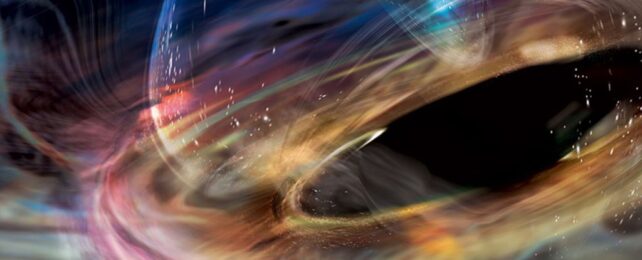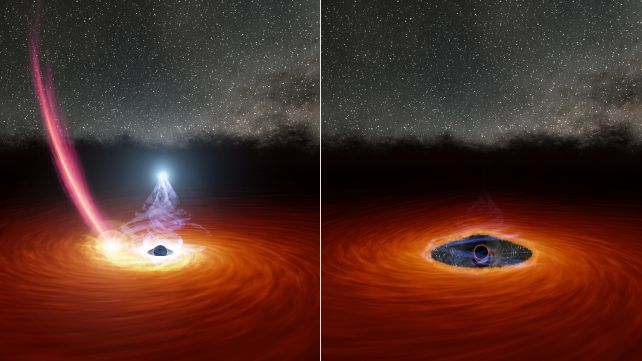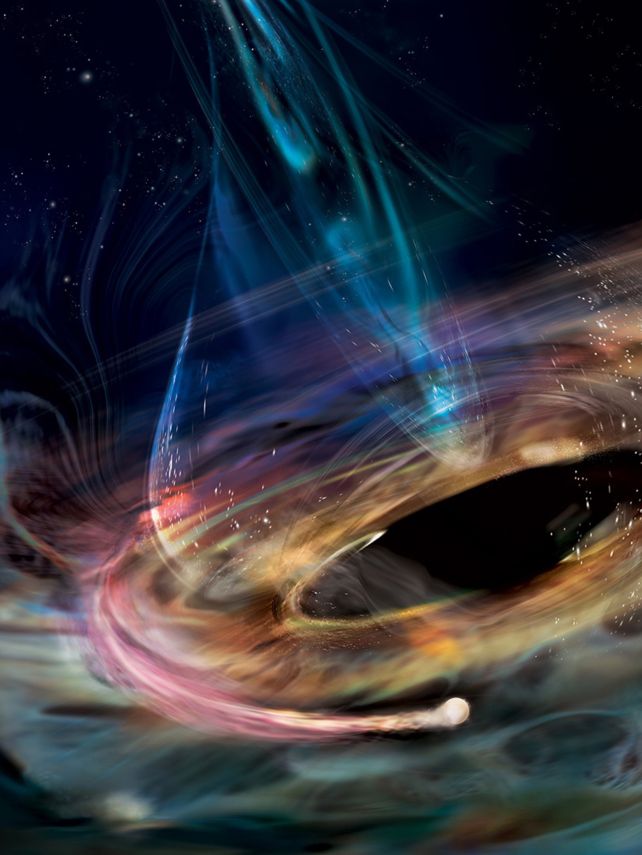So what in the Universe could be going on? To figure that out, the researchers needed to examine the clues: the wavelength of light and the periodicity of the flickering.
Strange Flashes Could Be Signs of Closest Object Seen Near a Black Hole
 An artist's impression of the extreme gravitational environment around the supermassive black hole of 1ES 1927+654 (Aurore Simonnet/Sonoma State University)
An artist's impression of the extreme gravitational environment around the supermassive black hole of 1ES 1927+654 (Aurore Simonnet/Sonoma State University)There, in the heart of a galaxy named 1ES 1927+654, squats a supermassive black hole whose monkeyshines and hijinks have baffled astronomers for years.
Now, we might finally have an explanation for at least some of its wild misbehavior: an orbiting white dwarf star veering precariously close to the brink of the black hole's event horizon, the point beyond which no matter can ever return.
"This would be the closest thing that we know of around any black hole," says physicist Megan Masterson of the Massachusetts Institute of Technology. "This tells us that objects like white dwarfs may be able to live very close to an event horizon for a relatively extended period of time."
Black holes themselves emit no light, but the supermassive black holes at the centers of galaxies are often surrounded by huge clouds of material. It's this material, heated by friction and gravity as it swirls in orbit around the black hole, that blazes with light.
When this light changes, astronomers can study it to figure out what events might be taking place in the black hole's vicinity. For example, we know what it looks like when a passing star gets caught in a black hole's gravitational field and torn asunder to be devoured over time.

- This was puzzling. One analysis suggested that it might be the result of a black hole polar reversal. Having never never seen anything like it before, scientists kept an eye on 1ES 1927+654 to see if anything else of note occurred.
X-ray data recorded by the European Space Agency's XMM-Newton space telescope showed that the galactic nucleus had started fluctuating in brightness. The X-ray output of the black hole was varying by about 10 percent, on timescales of around 18 minutes.
This is not unheard-of black hole behavior. Such fluctuations are known as quasi-periodic oscillations, and their exact cause or causes are unknown. But 1ES 1927+654 just had to make it even weirder. Over the course of two years, the time between the fluctuations narrowed from around 18 minutes to under seven.

. . ."Seeing something in the X-rays is already telling you you're pretty close to the black hole," says physicist Erin Kara of MIT. "When you see variability on the timescale of minutes, that's close to the event horizon, and the first thing your mind goes to is circular motion, and whether something could be orbiting around the black hole."
- That means this object is whipping around an event horizon with a radius 4.2 times that of our Sun's in just seven minutes.
This could mean that it will eventually retreat away from the black hole to a safer distance. If the team's analysis is correct, they will be able to observe this retreat in a lengthening period in the X-ray oscillations.
"The one thing I've learned with this source is to never stop looking at it because it will probably teach us something new," Masterson says. "The next step is just to keep our eyes open."
The research has been presented at the 245th meeting of the American Astronomical Society. It has also been accepted in Nature, and is available on preprint server arXiv.


No comments:
Post a Comment